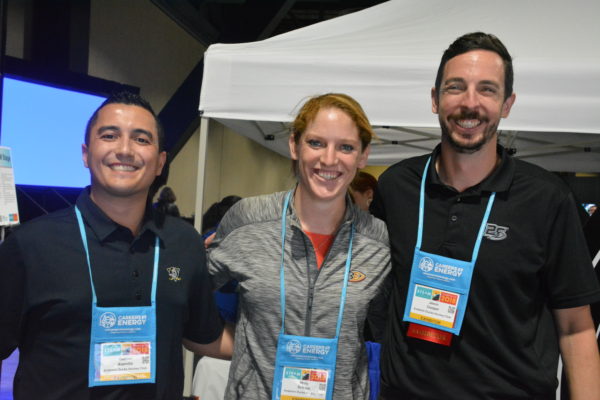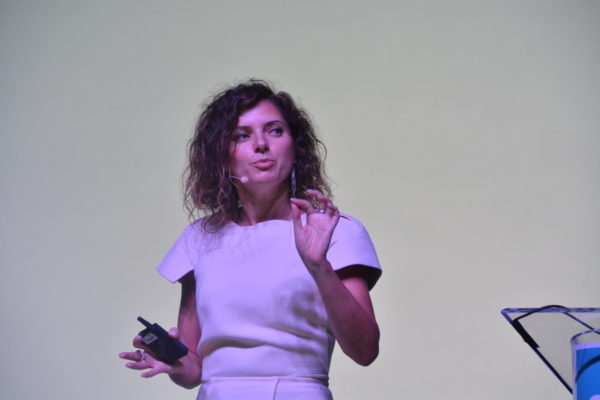by Dot Cannon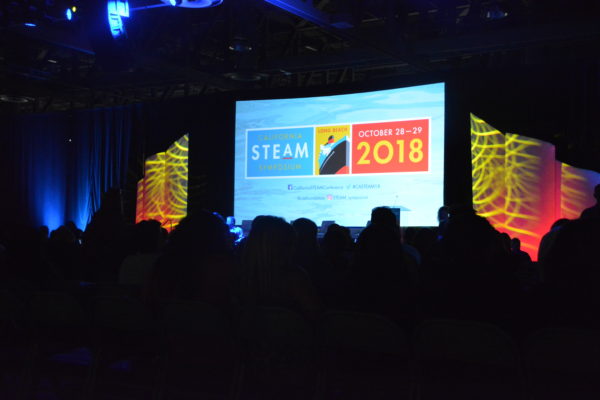
Who knew that a hockey goalie’s mask could be a work of art?
Or that a “zombie infection” could result in students learning math and science?
Or, that what we say can subconsciously affect not only our perception, but others’ perceptions, of the world?
All of the above are takeaways from Day One of the 2018 California STEAM Symposium, on Sunday at the Long Beach Convention Center.
Education professionals from over thirty states were on hand. So were attendees from Germany and Canada. And their goal: to continue integrating fun and creativity into their students’ educational journey.
New maker skills and innovation, in the areas of science, technology, art and math, would help them accomplish that.
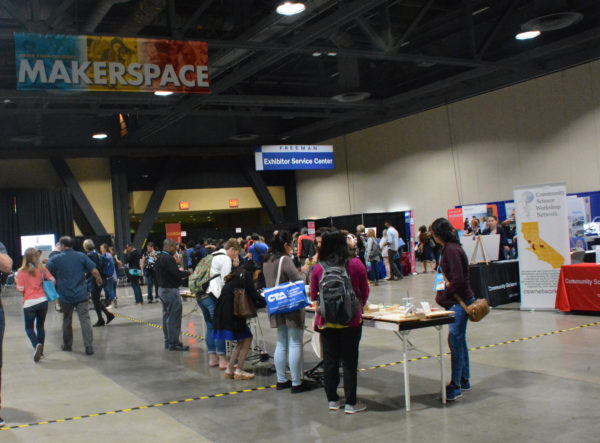
Downstairs, on the exhibit floor, stood a 5000-square-foot makerspace, hosted by Community Science Workshop Network.
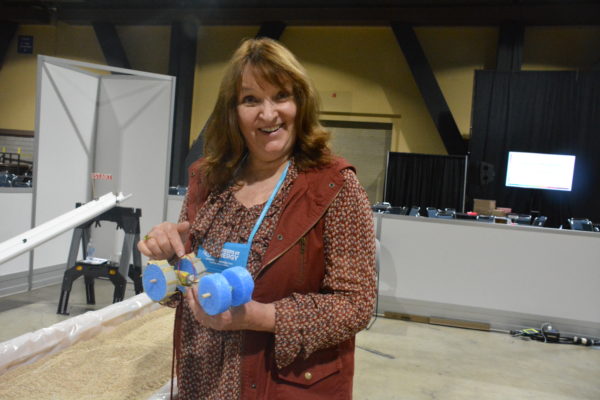
Wendy York, of Community Science Workshop Network, showed us how this rover has traction on its rear wheels, to navigate “rough terrain”!
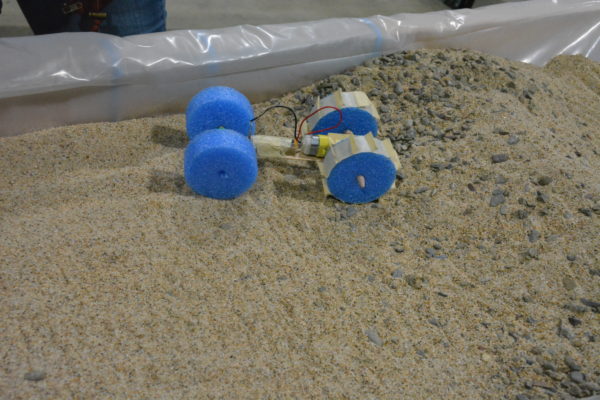
As CDE Foundation CEO Shelly Masur explained during her General Session introduction, the STEAM symposium started five years ago.
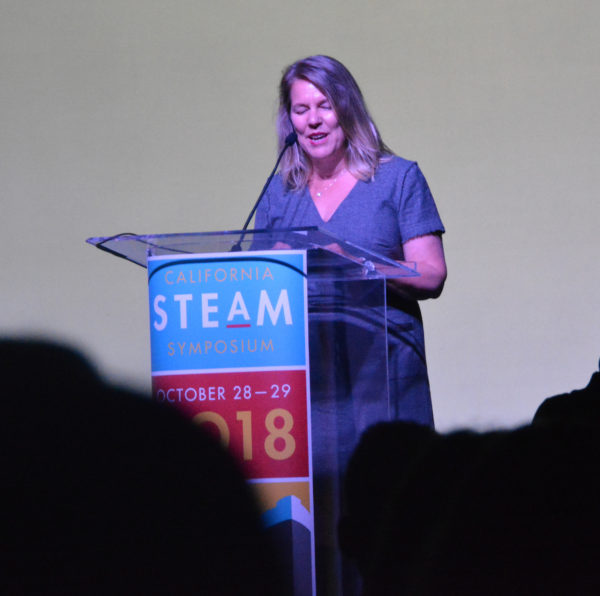
“In 2013…our State Superintendent, Tom Torlakson, with his deputy, Lupita Cortez Alcala, dreamed up this idea that we needed a conference focused on STEM education. And that year, 2,000 of you showed up for our very first STEM symposium.”
Since then, organizers have added the arts–turning STEM to STEAM.
And that arts slant was very much present on Sunday.
The science behind storytelling
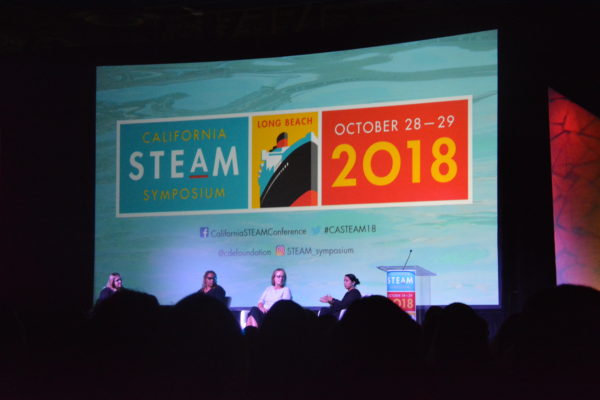
The first General Session panel featured four entertainment professionals.
Fox 2000 Executive Vice President Gillian Bohner moderated the panel on “STEAM to Screen: Careers in Storytelling Through Science”. The relationship of art to science, and vice versa, came up early on.
“Science and art both ask questions that emerge from the curious mind,” said writer-producer Nazrin Choudhury.
“The question they both ask is, ‘what if?'”, said Grey’s Anatomy executive producer/writer Zoanne Clack.
Professional screenwriter Barbara Nance said accurate science was essential to her storytelling.
“My first show, a woman gets pregnant by an alien being. I did a lot of research on pregnancy. You have to take these fantastical concepts and ground them (in scientific fact).”
Graphs, ghouls and technology
Later that morning, the subject was the undead.
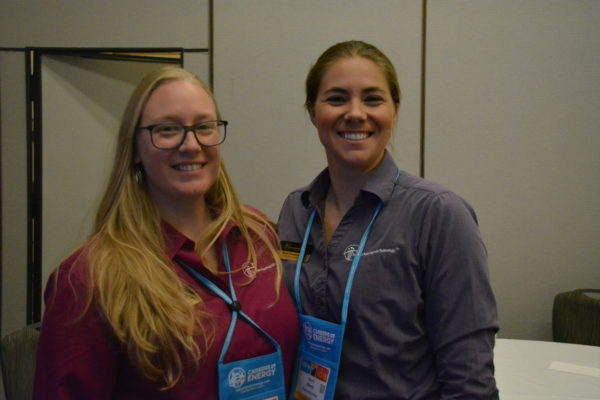
Randi Munch and Jennifer Waters, from Southwest High School in San Diego, offered a session on “Bringing Science and Math Together Using…ZOMBIES!”
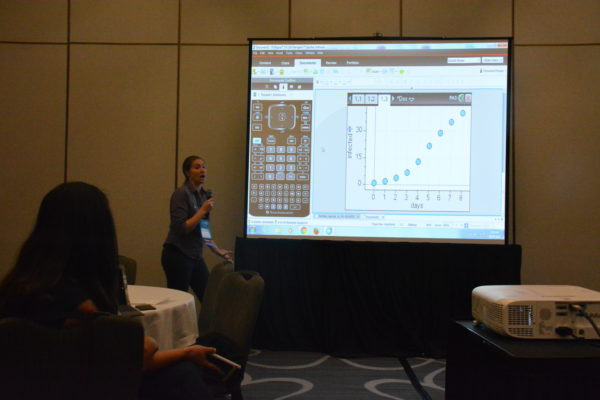
In their session, they graphed exponential figures of a flulike “zombie infection”. For the science component, their scenario included the ways the “zombie virus” affected the different part of the brain. The amygdala, for example, could be affected when a new “zombie” experiences anger and rage.
They even had an app that showed a normal human in the four stages of “zombie infestation”!
A bright future
Meanwhile, the STEAM Student Showcase was going on in the Convention Center lobby.
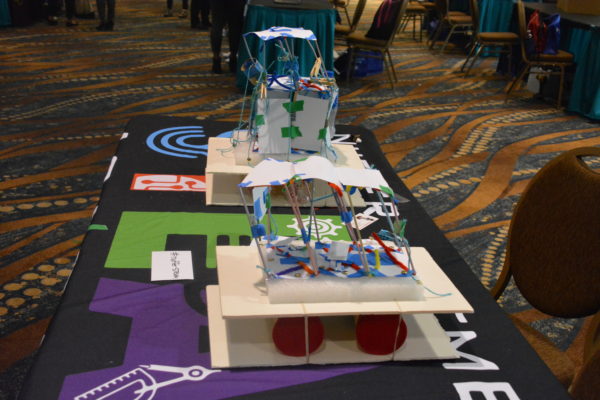
We were more than a little bit wowed by these models which Nuffer Elementary fifth-graders created. They built them in three days! Their purpose: to illustrate earthquake safety.
“Bad things can happen (during an earthquake if you’re not holding on),” one student explained, rolling the model as a small, plastic figure inside tumbled over.
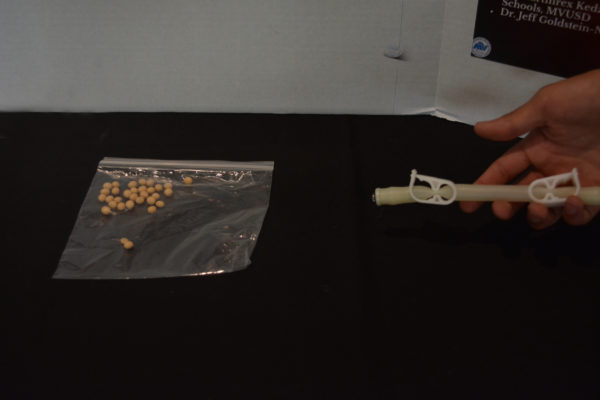
At a table across the room, Moreno Valley student Roman Lara Delgado explained his project. He and his Valley View High School research teammates had sent two soybeans up to the International Space Station!
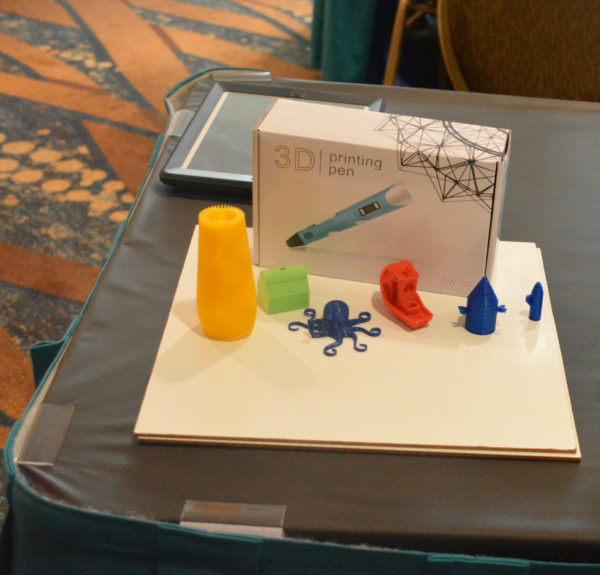
Meanwhile, Redlands High School sophomore Vidhi discussed art–3D printing style. She had created the small octopus as a gift for a friend. But, she said, she had another friend whose artistic talents with this tool amazed her.
“She made a flowerpot with (a detailed flower) in it. It took her three hours and she was like, ‘Please like it’,'” she said.
And we were similarly wowed–and a little scared!–by two La Crescenta students. Clark Magnet juniors Alaina and Tsoler told us they’d been researching the albatross.
“Their wings lock in place,” Alaina said. She and Tsoler had learned that the birds regurgitate indigestible items, such as beaks of their prey, before a long flight.
But, the scary part? They’d dissected an albatross, and found, not only indigestible portions of their previous meals, but plastic shards.
(“They ingested plastic, and we do, too, from our environments,”) she said.
The art of hockey
And–did you know that the Anaheim Ducks have a STEM curriculum, the S.C.O.R.E. program? AND that they have an upcoming “First Flight Field Trip”? (We didn’t–until we met Molly, Jason and Gabriel on the exhibit floor!)
Fan Development Marketing Manager Molly Schaus said the S.C.O.R.E. program is now in its eighteenth year.
So–physics would definitely be a part of hockey. But, what about art?
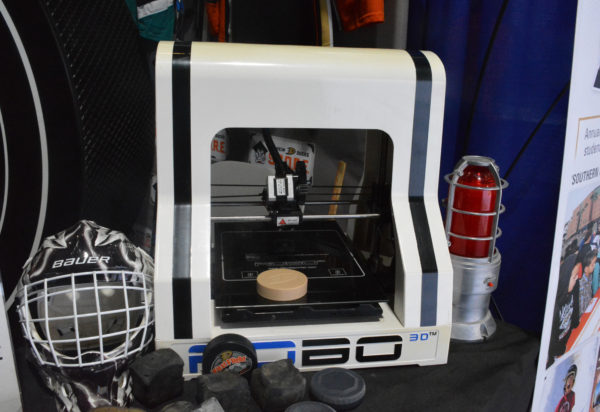
The pucks are 3D printed! And Manager of Fan Development Marketing Jason Cooper said the goalie’s mask is the one uniform item that can be customized. So goalies often add symbols and decorations that are meaningful to them.
Language and our thought processes
A highlight of the afternoon was the general session, featuring UCSD Associate Professor of Cognitive Science Lera Boroditsky.
In her presentation, “How the Languages We Speak Shape the Ways We Think”, she explained some of the different ways words affect perception in different cultures.
“There is an amazing teacher that all of us have, and that is language,” she said.
“Humans don’t communicate in just one language. We communicate in about 7,000 different (ones)”.
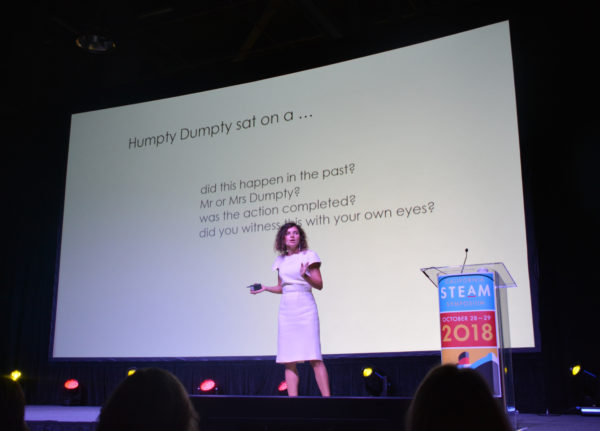
Using the classic nursery rhyme, “Humpty Dumpty”, as an example, she outlined the ways some cultures and languages might recount the story.
“In some languages, like in Russian, my native language, you’d have to change the gender, as well as the tense,” she explained. “In other languages, you have to mark how you (received the information). Turkish, for example.”
With languages that assign a gender to a noun, she continued, cultures subconsciously characterize as a result.
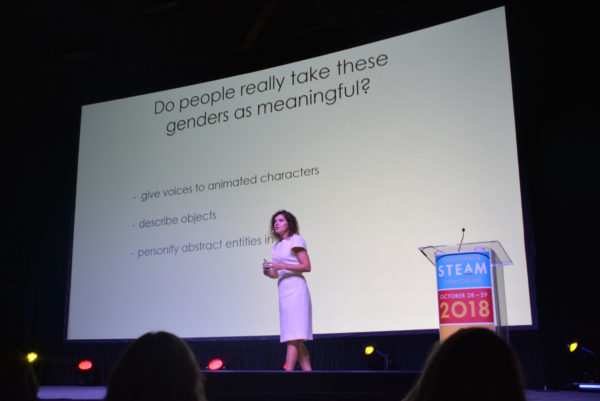
In Spanish, Professor Boroditsky said, the word “sun” is masculine, but in German, it’s feminine. When people from each of these cultures were asked to give voices to animations of the sun, they tended to do a masculine or feminine voice, based on the gender of the word.
Words place the blame
And language, she continued, plays a key role in the way we assign blame for an incident.
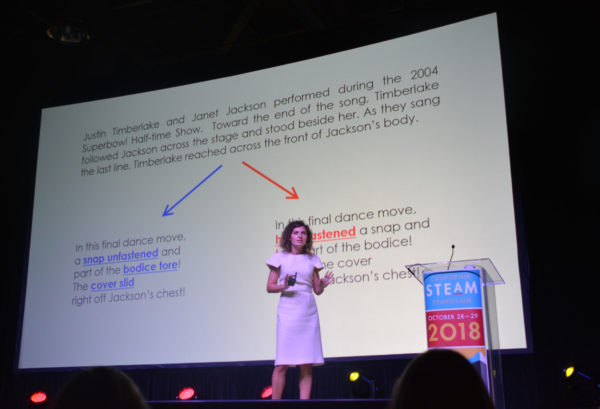
Referencing the infamous 2004″Superbowl wardrobe malfunction” involving Janet Jackson and Justin Timberlake, Professor Boroditsky told the audience of a survey.
One survey group, she said, read an account of the incident with the words, “a snap unfastened”. Another had the same account, but with the words, “he unfastened a snap”.
Both groups were asked how for much of the resulting fines Timberlake should be liable.
The group who read “he unfastened a snap”, felt he should pay 53% more in fines!
A fascinating session–and a fantastic Day One of California STEAM Symposium! We’re looking forward to Day Two.
Exhibits and the makerspace open at 7:00 Monday morning, October 29th,in the Long Beach Convention Center for Day Two of California STEAM Symposium 2018. Day Two runs until 5:00 pm.

